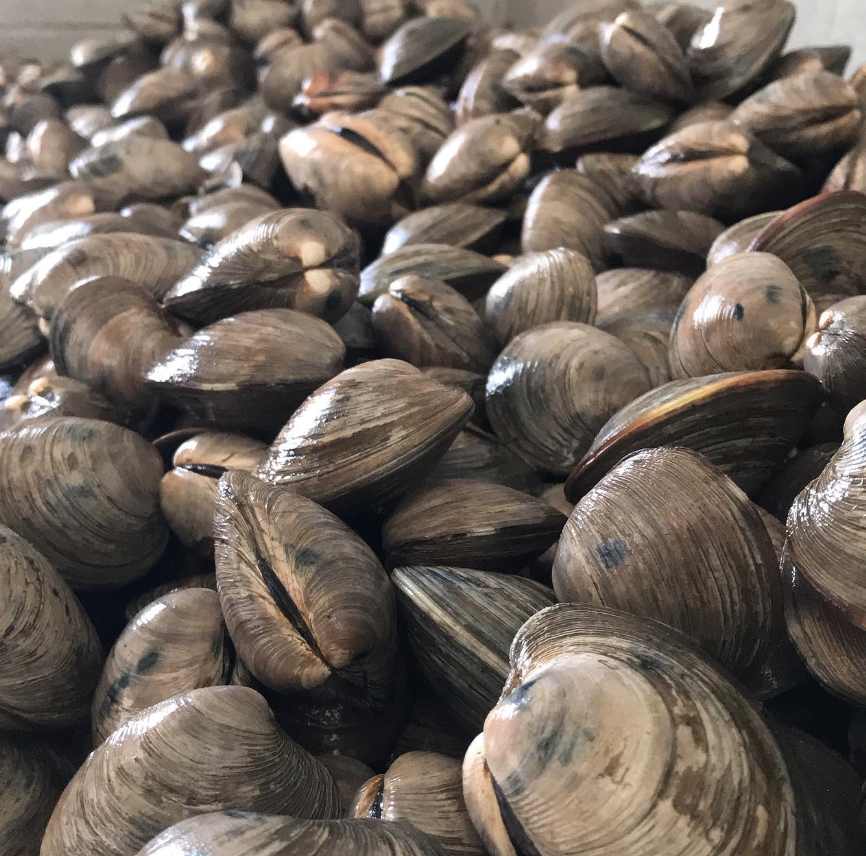
Clams
About clams
Quahogs (aka Atlantic hard-shell or hard clams) are abundant through the Northeast. “Littleneck” clams are the smallest size of commercially harvested quahogs, with usual market size around 1.5-2 inches wide (or 6-10 clams per pound). "Choice" clams are larger than littleneck clams but smaller than cherrystones or topnecks (around 2-3 “ wide). They are named after Little Neck Bay on Long island, which was once the center of the quahog industry. Like other clams, hard clams are filter feeders, which means they suck in water and eat tiny particles floating in the water. Littleneck clams have many predators, including octopus, sea stars, crabs, larger fish, and sharks. If you come across a so-called “Pacific littleneck” on the West Coast, that’s an entirely different species of clam.
Storage and Cleaning
Storing:
- Store live clams in a cold (40° F or lower) refrigerator in an open container, covered with a moist cloth or paper towels. Kept in this manner, live clams should remain fresh for two to three days. Do not put live clams in an airtight container or submerge them in fresh water; either will kill them.
- Clams can be frozen either in the shell or shucked. If properly frozen, they can last up to four months. To freeze clams in the shell, clean the clams (as described below), and place the live clams in moisture-vapor resistant bags. Press out excess air and freeze. To freeze the clam meat, shuck the clams, then clean and wash the meat thoroughly. Drain and pack in freezer containers, leaving ½-inch headspace. Seal, label and freeze. We do not recommend freezing cooked clams - you could end up with soft or rubbery meat.
Cleaning:
- To clean clams, they need to be "purged," another word for removing sand or grit that may be inside the clam shell.* Sort through clams and discard any open ones that don’t close when tapped. Handling the clams with care, put them in a large bowl, pot, or other vessel of salted, room-temperature water. Set aside for 20 minutes. Remove the clams from the bowl, discard the dirty water, and add a new round of salted, room-temperature water. Put the clams back in the bowl and set aside for another 20 minutes. When done, thoroughly scrub each clam with a small brush to remove grit from the exterior. Your clams are ready for cooking!
*Note: Though purging helps ensure your clams are grit-free, you may decide it’s not worth the effort. George Mathis, third-generation farmer, doesn’t feel strongly about the need to purge — you get to taste the bay, he says! Either way, even if you don’t purge, it’s worth it to give the outside of your clams a good scrub, since much of the grit is lodged in the crevices of their shells.
Cooking
These clams are alive, and should stay alive until you cook them! To keep them happy:
- Keep them damp in your refrigerator, but don’t keep them in a plastic bag - they can’t breathe through the plastic. They like being loose in a crisper drawer, or in a fabric or mesh bag, or in a loosely covered bowl.
- If you find an open clam, you can tap it to see if it is still alive. If it is still alive, it will close up by itself when you tap it. If it doesn’t close up, it is dead and should be discarded. They should keep up to a week if stored carefully in the refrigerator.
More on clams
Indigenous history and stewardship: Historically the Narragansett people have waded and dove for these hard clams, and the word quahog is a corruption of the Narragansett name for them, Poquauhock. Aside from food, Native tribes prized the beautiful purple part of the clam’s inner shells for making Suckanhoc, or black money, which was worth twice the value of wampum, or white money, made from conch. Traders used Suckanhoc along the East Coast, and even West into the Plains, with Suckanhoc having been found in circulation among the Sioux and Chippewa tribes. Native tribes have also used clam shells for storytelling, ceremonial gifts, ornaments, recording important events or treaties, or for making tools like scrapers, knives, spoons, and hoes. Early white settlers appropriated and began mass producing clam shells as money, particularly in the fur trade. The mass production of wampum led to its inflation and demise as a currency.
Where? Quahogs (aka Atlantic hard-shell or hard clams) are abundant through the Northeast, and if you go digging for clams in Jersey that’s likely what you’re digging for. The hard clam is native to the eastern shores of North America and Central America (from Prince Edward Island to the Yucatán Peninsula). The hard clam buries itself in shallow mud or sand in the ocean.
Life cycle? Clams feed year-round, though they feed less in winter because they need less energy. Clams can live for 10-12 years. Some may have lived for as long as 28 years. In 2007, scientists discovered a specimen of the ocean quahog that was between 405 and 410 years old. Clams have no eyes, ears, or noses, so they cannot see, hear, or smell. Once clams die crabs use their shells to hide from larger predators. Clams has a large, heavy shell that ranges from being a pale brownish to shades of gray, black, and white.
Taste! If you eat clams raw on the half-shell, you’re likely eating littlenecks, as their meat is mild, sweet, and tender!
Sources: The Chesapeake Bay Program, Spruce Eats, “American Seafood” by Barton Seaver.
Photo: @maxwellshellfish, dry bay clams
Last updated: 01/3/2023